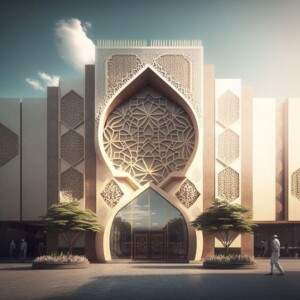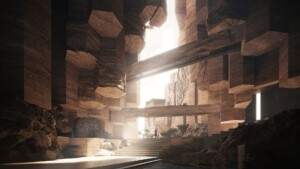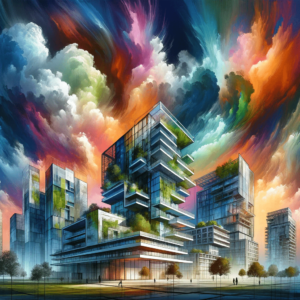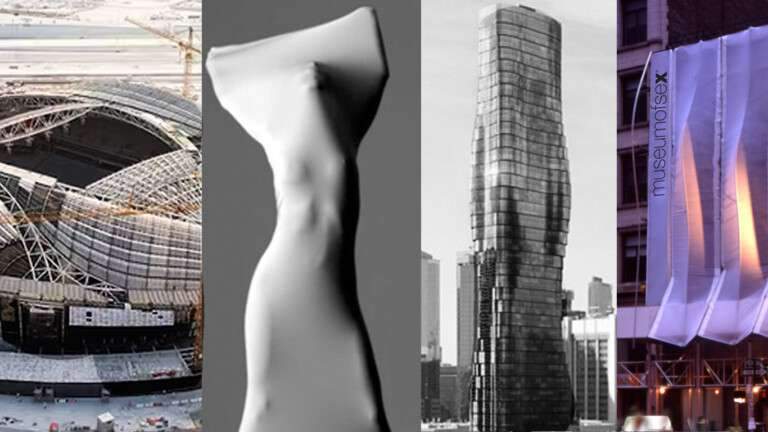Innovations in Modern Architecture
As the world of architecture continues to evolve, so too does the need for innovative and boundary-pushing designs. In recent years, the integration of artificial intelligence (AI) into the realm of architectural innovations has become a topic of great interest and discussion. From assisting architects in the design process to revolutionizing the way architectural competitions are held, AI is poised to change the face of the architectural industry. In this blog, we will explore the exciting possibilities that AI brings to the field of architecture and delve into the ways in which architects and designers can harness its power to create groundbreaking structures and spaces. Whether you are a seasoned architect or simply have an appreciation for the art of design, join us as we decipher the future of architecture with the integration of AI.
Introduction:
In this section, we will take a closer look at the current state of artificial intelligence in architecture and explore how it is being used to enhance the design process. With advancements in machine learning and data analysis, AI is now capable of generating complex architectural solutions that were previously unimaginable. Architects are increasingly relying on AI algorithms to assist in the early stages of design, providing them with valuable insights and alternatives that help push the boundaries of creativity. By harnessing the power of AI, architects can explore innovative design possibilities, optimize building performance, and achieve greater sustainability. In the following sections, we will dive deeper into the various applications of AI in architecture and discover how it is revolutionizing the industry. Stay tuned for the exciting possibilities that lie ahead!
Brief overview of contemporary architectural trends.
With the integration of artificial intelligence into the field of architecture, the possibilities for innovative design are endless. However, architects need to be aware of the current trends in the industry in order to stay relevant and meet the demands of clients. In this section, we will provide a brief overview of some of the contemporary architectural trends that are shaping the future of the profession.
One key trend in architecture today is the focus on sustainability and eco-friendly design. With global concerns about climate change and the need for more sustainable cities, architects are incorporating green building practices into their designs. This includes the use of renewable energy sources, such as solar panels and wind turbines, as well as the integration of green spaces and natural elements into urban environments.
Another trend that is gaining popularity is the concept of flexible and adaptable spaces. As cities become more crowded and space becomes limited, architects are finding creative ways to maximize the functionality of buildings. This can include the use of movable walls, modular furniture, and multi-purpose spaces that can easily be reconfigured to meet different needs.
Additionally, the incorporation of technology into architectural design is becoming increasingly prevalent. Smart buildings, equipped with sensors and automation systems, can enhance the efficiency and usability of spaces. From controlling lighting and temperature to managing security and resource usage, technology is revolutionizing the way buildings are designed and operated.
By staying informed about these trends, architects can ensure that their designs are not only innovative but also responsive to the needs of the community and the environment. In the next section, we will delve deeper into these trends and explore how artificial intelligence is playing a role in their development. So don’t forget to join us as we continue to unravel the exciting world of AI in architecture.

Importance of staying updated in the fast-evolving field of architecture.
It is crucial for architects to stay updated with the fast-evolving field of architecture. With advancements in technology and the integration of artificial intelligence, the profession is experiencing rapid changes. By staying informed, architects can effectively incorporate new trends and technologies into their designs, ensuring that they remain competitive in the industry.
Staying updated allows architects to understand and effectively respond to the evolving needs of clients and communities. By keeping up with the latest trends in sustainability and eco-friendly design, architects can create buildings that have a positive impact on the environment while meeting the demands of environmentally conscious clients.
Additionally, being aware of the concept of flexible and adaptable spaces enables architects to optimize the functionality of buildings, even in limited spaces. This trend is particularly important in today’s crowded cities, where the efficient use of space is essential.
Furthermore, staying updated with technological advancements allows architects to integrate smart and automated systems into their designs. This not only enhances the usability and efficiency of buildings but also aligns with the increasing demand for smart and connected spaces.
In conclusion, staying updated in the field of architecture is of paramount importance. It allows architects to incorporate the latest trends and technologies into their designs, ensuring that they remain relevant and competitive in the rapidly evolving architectural landscape. So, let’s dive deeper into the role of artificial intelligence in architectural innovations in the next section. Stay tuned!
Latest Architectural Design Trends:
Now that we understand the importance of staying updated in the field of architecture, let’s explore some of the latest architectural design trends that are shaping the industry. One major trend is the integration of artificial intelligence into architectural innovations. AI has the potential to revolutionize the way buildings are designed, constructed, and operated.
AI technologies, such as machine learning and neural networks, can analyze vast amounts of data, allowing architects to create more precise and efficient designs. These technologies can assist in generating design options, optimizing building performance, and even predicting user behaviors.
Moreover, AI-powered tools can enhance the collaboration between architects, engineers, and other stakeholders by enabling real-time simulations and data-driven decision-making. This not only streamlines the design process but also improves the overall quality and sustainability of architectural projects.
In the realm of construction, AI can improve safety and productivity by autonomously monitoring construction sites, identifying potential hazards, and managing construction schedules. Additionally, AI-powered robotics can assist in complex construction tasks, reducing labor costs and construction time.
In the coming sections, we will delve deeper into the specific applications of AI in architecture and explore how architects can harness this technology to push the boundaries of innovative design. So, stay tuned as we unravel the enigmatic world of AI-integrated architectural innovations.
Redefining Design Possibilities: AI as a Creative Collaborator
In the ever-evolving world of architecture, the integration of artificial intelligence (AI) opens up endless possibilities for design innovation. AI can not only augment the capabilities of architects but also act as a creative collaborator, pushing the boundaries of what was once deemed possible.
One of the most promising areas where AI brings a fresh perspective is the generation of design options. By analyzing vast amounts of data and learning from past projects, AI technologies can propose new and imaginative design possibilities that may have been overlooked by human designers. This collaboration between human creativity and AI’s computational power can ignite groundbreaking ideas and foster a sense of serendipity in the design process.
Furthermore, AI can optimize building performance by simulating and testing different scenarios to determine the most efficient and sustainable solutions. By considering various factors, such as energy consumption, thermal comfort, and structural integrity, AI can assist architects in making informed decisions that minimize environmental impact and maximize user satisfaction.
The integration of AI into the architectural realm also extends to predicting user behaviors. By analyzing user patterns and preferences, AI algorithms can anticipate how occupants will interact with the built environment. This allows architects to create spaces that are intelligently tailored to users’ needs, enhancing functionality, and user experience.
In the following sections, we will explore specific AI applications that are reshaping architectural design, such as parametric design, generative algorithms, and virtual reality. With each innovation, we inch closer to a future where AI is not just a tool but a creative entity that redefines the very essence of architectural innovation. So, join us on this thrilling journey as we unravel the enigmatic world of AI-integrated architectural design.
Summary of current trends in architectural design.
Summary of Current Trends in Architectural Design
As we delve deeper into the world of AI-integrated architectural design, it is important to take a moment to understand the current trends shaping the field. One prominent trend is the rise of parametric design, which allows architects to create complex, organic shapes and forms by defining and manipulating parameters. This approach gives rise to unique and innovative designs that would be almost impossible to achieve through traditional means.
Generative algorithms are also revolutionizing architectural design by autonomously producing multiple iterations of a design based on specific criteria. This not only saves time but also encourages exploration and experimentation, leading to more optimized and creative solutions.
Virtual reality is another trend that has gained significant traction in the architectural community. Architects are now using VR technology to create immersive experiences, enabling clients to visualize and experience their future spaces before they are even built. This level of realism and interaction has revolutionized the design process, allowing for a more comprehensive understanding and evaluation of architectural concepts.
In the next sections, we will delve deeper into each of these trends, exploring their benefits and potential for shaping the future of architecture. By staying up-to-date with these developments, architects can embrace the transformative power of AI and create designs that push the boundaries of innovation and redefine the architectural landscape.
Examples of notable recent projects.
Examples of Notable Recent Projects
To further understand the impact of integrating artificial intelligence into architectural design, let’s explore some notable recent projects that have embraced these emerging trends.
One exemplary project is the Blooming Bamboo Pavilion in China. Utilizing parametric design principles, architects were able to create a stunning pavilion with a complex, organic structure mimicking the growth patterns of bamboo. The intelligent algorithms allowed for precise manipulation of parameters, resulting in a visually captivating and structurally efficient design.
Another remarkable project is the Generative Skyscraper in Singapore. By employing generative algorithms, architects were able to generate multiple design iterations based on specific criteria such as sunlight exposure, wind patterns, and energy efficiency. This approach led to the creation of a skyscraper that not only harmonizes with its surroundings but also optimizes its functionality and sustainability.
VR technology has also been implemented successfully in the architectural field, as demonstrated in the Virtual Showroom project by a renowned design firm. Through an immersive virtual reality experience, clients can explore different design options, visualize the use of space, and make informed decisions about their projects before construction begins. This level of realism and interaction empowers clients and streamlines the design process.
These notable projects exemplify how the integration of AI in architecture brings about groundbreaking innovations and transformative possibilities. In the following sections, we will investigate in more detail the implementation and potential benefits of parametric design, generative algorithms, and virtual reality in architectural design. Stay tuned to discover the exciting future that awaits us in the realm of enigmatic architectural innovations.

Sustainable Development in Architecture:
Sustainable development in architecture has become an increasingly important aspect in recent years. As we face environmental challenges and the need for a more environmentally-conscious approach in all industries, architecture is no exception. The integration of artificial intelligence in architectural design has the potential to greatly contribute to sustainable development by optimizing energy efficiency, reducing waste, and harmonizing buildings with their natural surroundings.
One prominent example of the application of AI in sustainable architecture is the Bioclimatic Tower in Dubai. By utilizing AI algorithms to analyze sunlight exposure and wind patterns, architects were able to design a tower that maximizes natural light and ventilation while minimizing energy consumption. The building’s shape and orientation were determined by these algorithms to create a structure that blends seamlessly with its environment and reduces the overall carbon footprint.
In addition to energy optimization, AI can also be used to incorporate sustainable materials and construction techniques in architectural design. By analyzing data on the sourcing, production, and lifespan of different materials, AI algorithms can assist architects in making informed decisions that prioritize sustainability and durability.
The integration of artificial intelligence into architecture not only revolutionizes the design process but also paves the way for a greener, more sustainable future. In the following sections, we will delve deeper into the specific ways in which AI can contribute to sustainable development in architecture, from eco-friendly materials to intelligent systems that monitor and optimize energy usage. Join us as we explore the unlimited potential of AI in shaping the world of sustainable architectural innovations.
Eco-Friendly Materials: A Pathway to Sustainable Architecture
Creating sustainable buildings goes beyond just energy optimization and efficient designs. The choice of materials used in construction plays a significant role in reducing the environmental impact of architecture. This is where the integration of artificial intelligence into the realm of enigmatic architectural innovations becomes essential.
AI algorithms can analyze vast amounts of data about various materials, including their sourcing, production methods, and lifecycle. With this information at hand, architects can make well-informed decisions about the materials they use, prioritizing those that are eco-friendly, renewable, and have a minimal carbon footprint.
For instance, AI can process data on the energy required to manufacture a particular material, its potential for recycling, and its durability over time. By using these insights, architects can choose materials that align with sustainable development goals and contribute to a greener future.
Furthermore, AI can identify innovative materials that were previously overlooked or underutilized due to their unfamiliarity or lack of market presence. This opens up opportunities for architects to explore novel, eco-friendly alternatives and push the boundaries of sustainable construction.
In the next section, we will explore how AI can go beyond material selection and enable intelligent systems that monitor and optimize energy usage, ensuring that sustainable architecture continues to advance towards a brighter and greener future. Stay tuned!
Discussion on the importance of sustainability in modern architecture.
Discussion on the Importance of Sustainability in Modern Architecture
In today’s world, where environmental concerns are at the forefront of global consciousness, architects need to prioritize sustainability in their designs. Modern architecture has the power to not only create stunning structures but also minimize their impact on the environment.
Sustainable architecture focuses on reducing energy consumption, utilizing renewable resources, and promoting long-term environmental stability. By incorporating sustainable practices, architects can contribute to a healthier planet and create spaces that are in harmony with the natural surroundings.
From utilizing solar panels and green roofs to implementing efficient insulation and waste management systems, sustainable architecture is a holistic approach. It considers not only the immediate needs of the occupants but also the overall impact on the ecosystem.
Moreover, sustainable architecture promotes the efficient use of resources, such as water and materials, reducing waste and carbon emissions. Through thoughtful design and innovative techniques, architects can create buildings that can adapt to changing needs and contribute to a more sustainable future.
In the following section, we will delve into how integrating artificial intelligence into architectural systems can further enhance the sustainability of buildings. By harnessing the power of AI, architects can optimize energy usage, enhance occupant comfort, and continue pushing the boundaries of sustainable architecture.
Highlighting key sustainable projects and materials.
Highlighting Key Sustainable Projects and Materials
In the realm of modern architecture, numerous sustainable projects and materials have emerged, showcasing the possibilities of environmentally friendly design. These projects demonstrate the commitment of architects to create structures that are not only visually appealing but also aligned with the principles of sustainability.
One remarkable example is the Bullitt Center in Seattle, Washington. Often referred to as the greenest commercial building in the world, this six-story building is entirely self-sufficient when it comes to energy usage. It incorporates solar panels, rainwater harvesting systems, and geothermal heating, among other sustainable features. The Bullitt Center sets a high standard for energy efficiency and demonstrates how buildings can generate and maintain their own power.
Another noteworthy project is the Vertical Forest in Milan, Italy. The architects behind this innovative design aimed to bring greenery back to urban landscapes. The building features numerous trees and plants on each balcony, providing improved air quality and fostering biodiversity within the city. The Vertical Forest demonstrates how architecture can integrate nature into the built environment.
Apart from these groundbreaking projects, sustainable materials have also been developed to reduce the environmental impact of construction. For instance, bamboo is gaining popularity as a sustainable alternative to traditional building materials like wood. Not only is bamboo abundantly available and rapidly renewable, but it also has excellent strength and durability properties.
Similarly, recycled materials such as reclaimed wood and recycled concrete are being used to reduce the demand for new resources and divert waste from landfills. These materials offer a sustainable solution without compromising on quality or aesthetics.
By highlighting these key sustainable projects and materials, we can gain a deeper appreciation for the innovative ideas and advancements within sustainable architecture. These projects serve as inspiration for architects to continue pushing boundaries and find new ways to integrate sustainability into their designs.
In the next section, we will explore the potential of artificial intelligence in enhancing the sustainability of architecture. By combining the power of AI with sustainable practices, architects can revolutionize the industry and pave the way for a greener future.

Technological Advancements in Architecture:
As the world continues to embrace the digital age, technological advancements have become an integral part of architecture. From the use of virtual reality in design to the integration of smart technologies, architects are exploring innovative ways to enhance the functionality and sustainability of their structures.
One significant technological advancement in architecture is the integration of artificial intelligence (AI). AI has the potential to revolutionize the way buildings are designed, constructed, and operated. By analyzing vast amounts of data, AI systems can optimize building performance, reduce energy consumption, and improve occupant comfort.
For instance, AI-powered algorithms can analyze climate data and building parameters to optimize heating, ventilation, and air conditioning systems. This can lead to significant energy savings and a more comfortable indoor environment for occupants. AI can also analyze occupancy patterns to optimize lighting and reduce energy wastage.
Furthermore, AI can assist architects in the design process by generating optimized and sustainable solutions. By using algorithms to analyze site conditions, material properties, and energy requirements, architects can create structures that maximize sustainability without compromising on aesthetics.
The use of AI in construction can also improve project management and efficiency. AI-powered systems can monitor construction progress, detect potential issues, and optimize workflows. This can result in faster construction timelines, reduced costs, and improved quality control.
In the realm of architectural innovations, AI holds immense potential. By harnessing the power of AI, architects can create structures that are not only visually striking but also sustainable and efficient. As technology continues to advance, architects must embrace these new tools and incorporate them into their design processes.
In the next section, we will delve deeper into the various applications of AI in architecture and explore the potential benefits and challenges that come with its integration. Stay tuned to uncover the future of AI in the realm of enigmatic architectural innovations.
Exploring the Potential Applications of AI in Architecture
Artificial intelligence (AI) has the potential to transform the field of architecture in numerous ways. In this section, we will delve deeper into the various applications of AI in architecture and explore the potential benefits and challenges that arise with its integration.
One of the most significant applications of AI in architecture is in the design process. AI-powered algorithms can analyze vast amounts of data and generate optimized and sustainable design solutions. This not only saves time and effort for architects, but also ensures that buildings are designed to maximize energy efficiency and occupant comfort.
AI can also play a crucial role in improving construction processes. By using AI-powered systems, architects and contractors can monitor construction progress, detect potential issues, and optimize workflows. This results in faster construction timelines, reduced costs, and improved quality control.
Furthermore, AI can be used to enhance the operation and maintenance of buildings. AI-powered systems can analyze data from sensors and other sources to optimize heating, ventilation, and air conditioning systems, lighting, and energy usage. This leads to significant energy savings and improved occupant comfort.
While the potential benefits of integrating AI into architecture are vast, there are also challenges that need to be addressed. Privacy and security concerns, ethical considerations, and the need for transparency in decision-making are some of the key challenges that arise with the use of AI in architecture.
In the next section, we will take a closer look at some specific examples of how AI is being integrated into the realm of enigmatic architectural innovations. Stay tuned to discover how AI is shaping the future of architecture.
Overview of how technology is influencing architectural design.
Overview of how technology is influencing architectural design
Technology is revolutionizing architectural design, and the integration of Artificial Intelligence (AI) is at the forefront of these advancements. AI-powered software and tools are providing architects with the ability to analyze complex data sets, generate optimized designs, and streamline the design process.
One area where technology is making a significant impact is in parametric design. With the help of AI, architects can create parametric models that can be easily manipulated, allowing for rapid iteration and exploration of design possibilities. This not only saves time but also enables architects to push the boundaries of creativity and innovation.
Virtual and augmented reality (VR/AR) technologies are also revolutionizing architectural design. Architects can now create virtual environments that provide clients and stakeholders with immersive experiences, allowing them to visualize and interact with designs before they are built. This not only enhances client communication but also enables architects to identify and address design flaws early in the process.
Additionally, Building Information Modeling (BIM) has transformed the way architects design and manage projects. BIM software combines 3D modeling, data management, and collaboration tools, allowing architects to create intelligent digital representations of buildings. This enables real-time collaboration, improves project coordination, and increases the efficiency of the construction process.
The integration of AI and technology into architectural design is opening up new opportunities for innovation and creativity. Architects now have access to powerful tools that can enhance design exploration, improve communication, and streamline project management. As technology continues to evolve, we can expect to see even more groundbreaking advancements in the world of architectural design.

Focus on specific innovations like 3D printing, AI in architecture.
3D Printing: Revolutionizing Architectural Construction
One of the most groundbreaking innovations in architectural design is the use of 3D printing technology. Using specialized printers and materials, architects can now create tangible models and even entire building components with unprecedented precision and efficiency. Gone are the days of painstakingly constructing physical models by hand – 3D printing allows architects to bring their designs to life in a matter of hours.
This emerging technology has the potential to revolutionize the construction industry. With the ability to quickly produce complex geometries and customize designs, 3D printing opens up new possibilities for architectural expression and sustainability. From intricate façades and structural elements to entire buildings, architects now have the tools to create structures that were once deemed impossible.
Artificial Intelligence in Architecture: Redefining the Design Process
Artificial Intelligence (AI) is playing a transformative role in the field of architecture. By analyzing vast amounts of data and learning from patterns, AI-powered software is capable of generating optimized designs that meet specific criteria, such as energy efficiency or cost-effectiveness. This not only saves architects time but also pushes the boundaries of what can be achieved in architectural design.
Furthermore, AI is revolutionizing the way architects approach problem-solving. Machine learning algorithms can analyze and predict the performance of design elements, optimizing structural integrity and environmental impact. This data-driven approach allows architects to make informed decisions based on objective insights, leading to more efficient and sustainable designs.
The integration of AI into architectural design not only streamlines the design process but also sparks creativity and innovation. With the ability to iterate and explore countless design possibilities, architects can push the boundaries of what is achievable in architectural aesthetics and functionality.
As the architectural industry continues to embrace technology and innovation, we can expect even more exciting advancements in the realm of 3D printing and AI. These innovations are reshaping the way architects design and construct buildings, propelling us into a future where the possibilities are limitless.
Artificial intelligence machine learning and its uses in architecture









